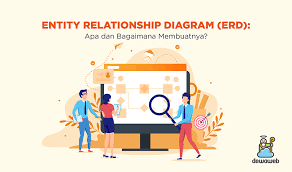- What is an Entity Relationship Diagram (ERD)
Entity Relationship Diagram or entity relationship diagram is a data model in the form of graphical notation in conceptual data modeling that describes the relationship between the store. The data model itself is a set of methods, tools for describing data that are related to each other, their semantics, and consistency constraints.
Source: https://images.app.goo.gl/56zNFsLKRKUdazKbA
The data model consists of an entity relationship model and a relational model. Entity relationship diagrams were discovered by Peter Chen in the book Entity Relational Model-Toward a Unified of Data. Chen tried to formulate the basics of the model and after that it was developed and modified by Chen and many other experts.
- Data Models
This= is the highest ER level model in that it contains the most granular details right but defines the overall scope of what should be included in the model set.ER Model. The conceptual framework usually defines the primary reference data entities commonly used by the organization.
Develop a conceptual ER model useful for supporting and documenting the data architecture for an organization. The conceptual ER model can be used as the basis for one or more logical data models.
The goal of the conceptual ER model is to establish a metadata structure of similarities for the entity master data between sets of logical ER models. Conceptual data models can be used to establish similarity relationships between ER models as a basis for data model integration.
- Logical Data Model
A logical ER model does not require a conceptual ER model, especially if the scope of the logical ER model only includes the development of different information systems. The logical ER model contains more detail than the conceptual ER model. In addition to the master data entities, operational and transactional data entities are now defined. Details of each data entity are developed and the relationships between these data entities are established. The ER model is logical but is developed independently of the specific database management system to which it can be implemented.
- Physical Data Model
One or more physical ER models may be developed from each logical ER model. Physical ER models are usually developed to be used as databases. Therefore, each physical ER model must contain enough detail to generate a database and each physical ER model is technology dependent because each database management system is somewhat different.
Physical models are typically used in the structural metadata of a database management system as relational database objects such as database tables, database indexes such as unique key indexes, and database constraints such as foreign key constraints or similarity constraints. The ER model is also commonly used to design modifications of relational database objects and to maintain the structural metadata of the database.
The need for digital IT is needed in daily activities, Bead IT Consultant is the right choice as your partner, visit our website by clicking this link: www.beadgroup.com

